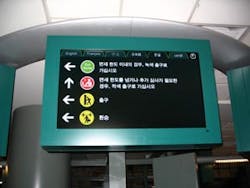Tech Bytes
The Vancouver International Airport Authority decided not long ago to enhance content through a digital signage initiative with Omnivex digital signage management software. The initiative has proven a major success for the airport, according to a case study by the Omnivex Corporation.
The airport was looking for signage solutions to aid facility navigation, improve Customs procedures, target and accommodate a diverse cross-section of travelers with multiple language displays, and inform and entertain passengers.
Because airport messages are time-sensitive, it was important that the system function in real time, integrate with existing data systems, and automate appropriate actions to decrease the need for human interaction.
Omnivex worked with Vancouver International Airport (YVR) in setting up a variety of LCD displays, plasma, and LED boards. All screen content is created and managed by YVR, using Omnivex display software. The system relies on data as context to determine content. Using Omnivex DataPipe and SQLLink software, YVR is able to interface with its existing flight information database as a content source and as a means of triggering the appropriate content to be displayed.
A key system feature allows all facility maps, directional instructions, and baggage claim information to be displayed in the language appropriate to the current flight schedule. For example, a flight arriving from Mexico City will have information shown in English and Spanish. The Omnivex software automates this process. The Customs and Immigration area features a large, full-color LED board that welcomes passengers and displays pertinent Canadian border crossing information in multple languages as well.
YVR also took steps to decrease perceived wait times in other areas of the airport by entertaining passengers using a live television feed with news and messages. The airport is able to provide television feeds economically by streaming television channels over their digital signage network.
Alice Kempff, business analyst, passenger services for YVR, says new content requirements will arise, but she is confident that the Omnivex system will meet the airport’s digital signage needs.
“We now have a system that allows us to easily design, create, and push content to any display on our network,” says Kempff.
YVR is experiencing benefits in airport operations by way of improved passenger satisfaction and reduced delays due to the automated display of information in appropriate languages. YVR’s eTV network decreases passenger anxiety and boredom, the airport says. Future content plans include the deployment of pre-designed emergency messages which can be immediately activated on the appropriate screens in cases of a security or evacuation alert.
Facing Biometric security
L-1 Identity Solutions, Inc and its enterprise access division, Bioscrypt Inc., has developed its next generation VisionAccess 3D face reader, an identity and access management solution targeted to corporate enterprise and government markets, including airports. The face reader aims to control entry and exit of secure areas and is optimized for high traffic volume and large workforces.
The face reader is expected to help increase the adoption of advanced biometrics for secure access. The most advanced 3D face processing capabilities allow user authentication in seconds. The system uses the entire facial surface structure of a person’s face in order to verify identity. The face reader can be used in conjunction with proximity cards, smart cards, and tokens for multi-factor authentication.
The reader includes the ability to store up to 60,000 face templates for large facility deployments and is Ethernet-ready for easy network connectivity. The next generation Vision Access 3D face reader is expected to be available yet this year, according to a company press release.
Demand response service
Ronald Reagan Washington National Airport (DCA) has partnered with EnergyConnect, which provides Demand Response technologies and services, to voluntarily reduce energy consumption when electricity is in peak demand and the electric grid is strained. Reagon National operates nearly 100 concessions and serves an average of 18.7 million passengers each year.
In an effort to reduce energy consumption, better manage its power needs, and generate new sources of revenue, the airport enrolled 12 megawatts of load into EnergyConnect’s FlexConnect demand response program, according to a press release. The program enables the airport to generate revenue by voluntarily curtailing power usage in response to high market prices or regional power shortages. This allows DCA to make informed, automated decisions about when to engage in electricity load shifting based on its operational flexibility and up-to-the-minute electricity market pricing.
As a result of DCA’s participation in demand response technology, the airport is able to contribute to a more efficient and reliable power grid while helping reduce greenhouse gas emissions from inefficient power generation.
* * *
Compiled by assistant editor Brad McAllister; reach him at [email protected].
